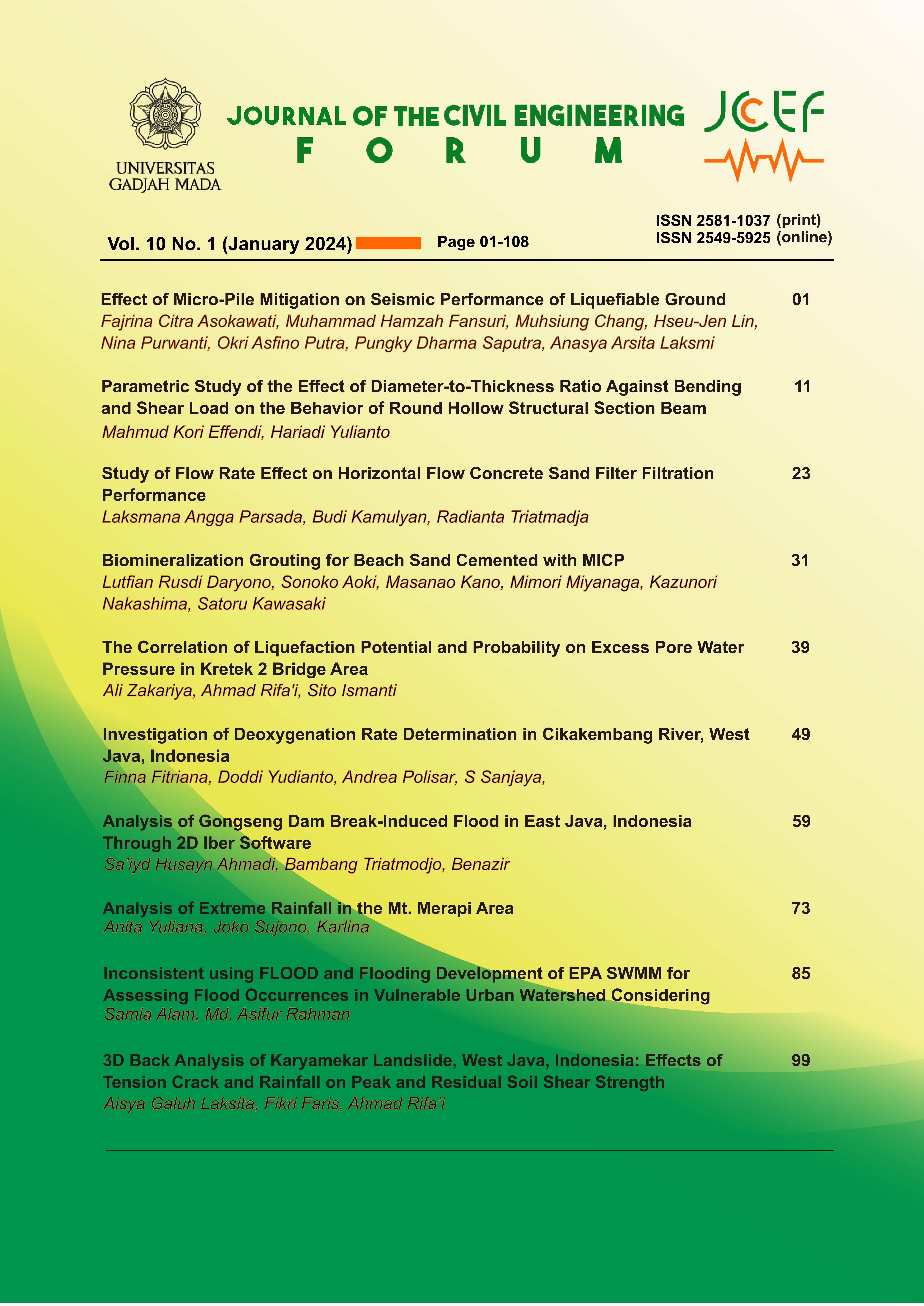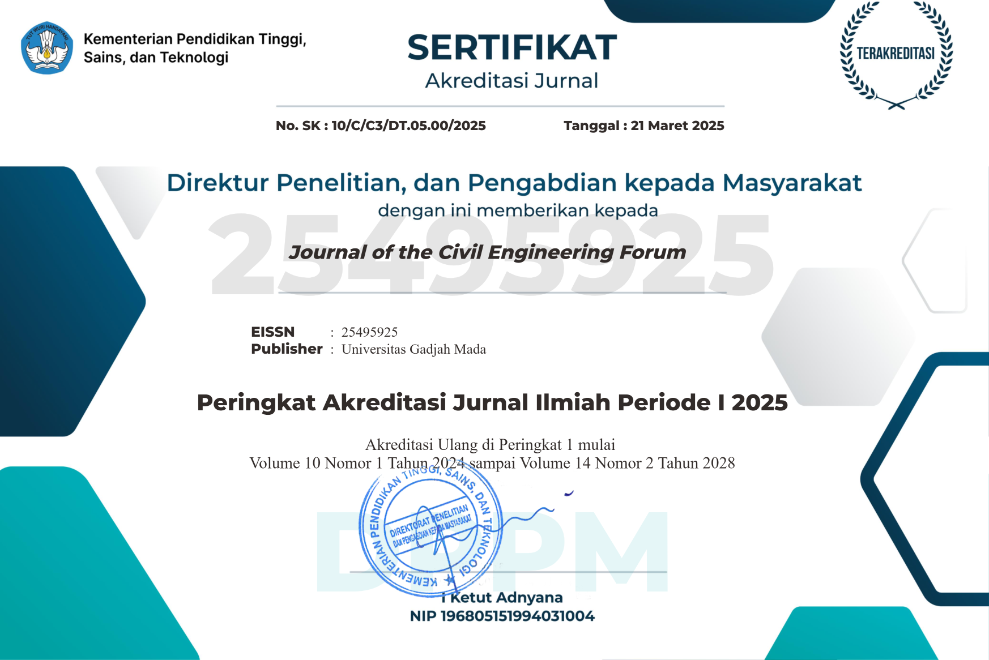Analysis of Gongseng Dam Break-Induced Flood in East Java, Indonesia Through 2D Iber Software
Abstract
The dam is a crucial river-crossing structure that ensures a sustainable water supply and offers numerous benefits. However, the potential hazard of dam failure is an imminent threat that could materialize unexpectedly. To comprehend the potential impact of dam break flood and identify vulnerable areas, it is essential to conduct rigorous analysis and simulate various dam failure scenarios. This comprehensive assessment is invaluable for informed land use planning and the development of effective emergency response plans. Therefore, this study aimed to analyze flood inundation resulting from the hypothetical failure of Gongseng dam, using Iber model. The modeling approach relied on a two-dimensional finite volume shallow water model, guided by specialized software. The scenarios for Gongseng dam break showed inundation areas of 12.57 km² and 7.55 km² for overtopping and piping failure, respectively. Overtopping failure resulted in the highest discharge, with Von Thun method causing severe damage due to wide break dimensions, and eventually leading to catastrophic consequences. However, this study showed that Froehlich method provided the most rational prediction for break parameters. In contrast to the other methods focusing solely on water height behind dam, Froehlich equation considered both the volume and height at the time of failure. Implementing dam break analysis held the potential to benefit downstream communities by providing inundation maps, thereby aiding in the mitigation of flood risks. Particularly, in situations with limited data and resources, as shown in this study, the cost-effective modeling method proposed could be an attractive option for simulating extreme flood induced by dam break.
References
Al-Weshah, R. A., Demissie, M. and Keefer, L. (1993), ‘The role of wetlands in stormwater runoff for the Flint and Mutton Creek watersheds, Lake County, Illinois’, ISWS Contract Report CR 562 .
Balai Bendungan, Direktorat Jenderal Sumber Daya Air, Kementrian Pekerjaan Umum dan Perumahan Rakyat (2019), ‘Konsep penyusunan rencana tindak darurat’.
Balai Bendungan, Direktorat Jenderal Sumber Daya Air, Kementrian Pekerjaan Umum dan Perumahan Rakyat (2019), ‘Konsep penyusunan rencana tindak darurat’.
Bharath, A. et al. (2021), ‘Dam break analysis using hec-ras and hec-georas: A case study of Hidkal dam, Karnataka state, India’, Environmental Challenges 5, 100401. URL: https://doi.org/10.1016/j.envc.2021.100401
Bladé, E., Cea, L., Corestein, G., Escolano, E., Puertas, J., Vázquez-Cendón, E., Dolz, J. and Coll, A. (2014), Iber: herramienta de simulación numérica del flujo en ríos. URL: https://doi.org/10.1016/j.rimni.2012.07.004
Bladé, E. et al. (2014), ‘Iber: herramienta de simulación numérica del flujo en ríos’, Revista Internacional de Mètodos Numèricos para Cálculo y Diseño en Ingeniería 30(1), 1–10. URL: https://doi.org/10.1016/j.rimni.2012.07.004
Bo, W. et al. (2015),‘A case study of the tangjiashan landslide dam-break’, Journal of Hydrodynamics 27(2), 223–233. URL: https://doi.org/10.1016/S1001-6058(15)60476-0
Cea Gómez, L., Bladé i Castellet, E., Sanz-Ramos, M., Bermúdez Pita, M. and Mateos Alonso, Á. (2019), Iber Applications Basic Guide, Universidade da Coruña, Servizo de Publicacións, A Coruña. URL: https://doi.org/10.17979/spudc.9788497497176
Cea, L. and Bladé, E. (2015), ‘A simple and efficient unstructured finite volume scheme for solving the shallow water equations in overland flow applications’, Water Resources Research 51, 5464–5486. URL: https://doi.org/10.1002/2014WR016547
Cea, L., Garrido, M. and Puertas, J. (2010), ‘Experimental validation of two-dimensional depthaveraged models for forecasting rainfall – runoff from precipitation data in urban areas’, Journal of Hydrology 382(1–4), 88–102. URL: https://doi.org/10.1016/j.jhydrol.2009.12.020
Cea, L., Puertas, J. and Vázquez-Cendón, M.-E. (2007), ‘Depth averaged modelling of turbulent shallow water flow with wet-dry fronts’,Arch Comput Methods Eng. pp. 303–341. URL: https://doi.org/10.1007/s11831-007-9009-3
Costa, J. E. (1985), Floods from dam failures, OpenFile Rep. 85-560, U. S. Geological Survey, Denver, Colorado. Evans, S. G. (1986), ‘The maximum discharge of outburst floods caused by the breaching of man-made and natural dams’, Can. Geotech. J. 23(3), 385–387. URL: https://doi.org/10.1139/t86-053
Feng, Z. et al. (2020),‘Two-dimensional numerical simulation of sediment transport using improved critical shear stress methods’,International Journal of Sediment Research 35(1), 15–26. URL: https://doi.org/10.1016/j.ijsrc.2019.10.003
Froehlich, D. C. (2008), ‘Embankment dam breach parameters and their uncertainties’, Journal Hydraullic Engineering 134, 1708–1721. URL: https://doi.org/10.1061/(ASCE)0733-9429(2008)134:12(1708)
Guo, L. et al. (2022), ‘Water demand forecasting and countermeasures across the yellow river basin: Analysis from the perspective of water resources carrying capacity’, Journal of Hydrology: Regional Studies 42, 101148. URL: https://doi.org/10.1016/j.ejrh.2022.101148
He, C. et al. (2021), ‘A new portable in situ flume for measuring critical shear stress on river beds’, International Journal of Sediment Research 36(2), 235–242. URL: https://doi.org/10.1016/j.ijsrc.2020.08.004
Hu, P., Xie, J., Li, W., He, Z., Marsooli, R. and Wu, W. (2020), ‘A rans numerical study of experimental swash flows and its bed shear stress estimation’, Applied Ocean Research 100, 102145. URL: https://doi.org/10.1016/j.apor.2020.102145
Jia, Y. and Wang, S. S. Y. (1999), ‘Numerical model for channel flow and morphological change studies’, Journal Hydraulic Engineering pp. 924–933. URL: https://doi.org/10.1061/(ASCE)0733-9429(1999)125:9(924)
Joshi, S., Patrick, G. and Brown, C. (2017), ‘Critical bed shear stress and threshold of motion of maerl biogenic gravel’, Estuarine, Coastal, and Shelf Science 194, 128–142. URL: https://doi.org/10.1016/j.ecss.2017.06.010
Kao, H. and Chang, T. (2012),‘Numerical modeling of dam-break-induced flood and inundation using smoothed particle hydrodynamics’, Journal of Hydrology 448–449, 232–244. URL: https://doi.org/10.1016/j.jhydrol.2012.05.004
Khosravi, K., Rostaminejad, M., Cooper, J. R., Mao, L. and Melesse, A. M. (2016), Dam break analysis and flood inundation mapping: The case study of Sefid-Roud Dam, Iran, in ‘Extreme Hydrology and Climate Variability’, Elsevier Inc. URL: https://doi.org/10.1016/B978-0-12-815998-9.00031-2
Kirkpatrick, G. W. (1977), Evaluation guidelines for spillway adequacy, in ‘Proc., Engineering Foundation Conf.’, ASCE, Reston, Va., pp. 395–414.
Kocaman, S. et al. (2020), ‘Experimental and numerical analysis of a dam-break flow through different contraction geometries of the channel’,Water 12, 1–22. URL: https://doi.org/10.3390/w12041124
Li, M. et al. (2022),‘Effects of antecedent soil moisture on rill erodibility and critical shear stress’, Catena 216(PA), 106356. URL: https://doi.org/10.1016/j.catena.2022.106356
MacDonald, T. C. and Langridge-Monopolis, J. (1984), ‘Breaching characteristics of dam failures’, J. Hydraul. Eng. 110(5), 567–586. URL: https://doi.org/10.1061/(ASCE)0733-9429(1984)110:5(567)
Mattas, C. et al. (2023), ‘Two-dimensional modelling for dam break analysis and flood hazard mapping: A case study of papadia dam, northern greece’, Water 15, 1–25. URL: https://doi.org/10.3390/w15050994
Mo, C. et al. (2023), ‘Simulation of onedimensional dam-break flood routing based on hec-ras’, Frontiers in Earth Science pp. 1–15. URL: https://doi.org/10.3389/feart.2022.1027788
Oliveira, A. M. et al. (2022),‘Loss of life estimation and risk level classification due to a dam break’, Heliyon 8, 1–12. URL: https://doi.org/10.1016/j.heliyon.2022.e09257
Petit, F. et al. (2015), ‘Dimensionless critical shear stress in gravel-bed rivers’, Geomorphology 250, 308–320. URL: https://doi.org/10.1016/j.geomorph.2015.09.008
Pierce, M. et al. (2010), ‘Predicting peak outflow from breached embankment dams’, Journal of Hydraulic Eng. pp. 338–349. URL: https://doi.org/10.1061/(ASCE)HE.1943-5584.0000197
da Hora, M. d. A. G., de Miranda Neto, M. I. et al. (2018), ‘Classification of the Juturnaíba Dam: Potential risk and damage’, Journal of Water Resource and Protection pp. 1–19. URL: https://doi.org/10.4236/jwarp.2018.101001
Singh, K. P. and Snorrason, A. (1982), Sensitivity of outflow peaks and flood stages to the selection of dam breach parameters and simulation models, Contract Rep. 288, State Water Survey (SWS). URL: https://doi.org/10.1016/0022-1694(84)90217-8
Singh, K. P. and Snorrason, A. (1984), ‘Sensitivity of outflow peaks and flood stages to the selection of dam breach parameters and simulation models’, J. Hydrol. 68, 295–310. URL: http://hdl.handle.net/2142/72707
U.S. Bureau of Reclamation (1982), Guidelines for defining inundated areas downstream from bureau of reclamation dams, Reclamation Planning Instruction Rep. 82-11.
Wahl, T. L. (2004), ‘Uncertainty of predictions of embankment dam breach parameters’, Journal of Hydraulic Engineering pp. 389–397. URL: https://doi.org/10.1061/(ASCE)0733-9429(2004)130:5(389)
Wang, X., Gualtieri, C. and Huai, W. (2023), ‘Grain shear stress and bed-load transport in open channel flow with emergent vegetation’, Journal of Hydrology 618(February), 129–204. URL: https://doi.org/10.1016/j.jhydrol.2023.129204
Wu, W. (2004), ‘Depth-averaged two-dimensional numerical modeling of unsteady flow and nonuniform sediment transport in open channels’, pp. 1013–1024. URL: https://doi.org/10.1061/(ASCE)0733-9429(2004)130:10(1013)
Álvarez, M. et al. (2017), ‘Two-dimensional dambreak flood analysis in data-scarce regions: The case study of Chipembe Dam, Mozambique’, Journal of Water pp. 1–19. URL: https://doi.org/10.3390/w9060432
Copyright (c) 2024 The Author(s)

This work is licensed under a Creative Commons Attribution-ShareAlike 4.0 International License.
Copyright is granted to authors for the purpose of providing protection for articles written to describe experiments and their results. JCEF will protect and defend the work and reputation of the author and are also willing to address any allegations of violation, plagiarism, fraud, etc. against articles written and published by JCEF. JCEF is published under the terms of the Creative Commons Attribution-ShareAlike 4.0 International License (CC BY-SA 4.0). The author holds the copyright and assigns the journal rights to the first publication (online and print) of the work simultaneously.







